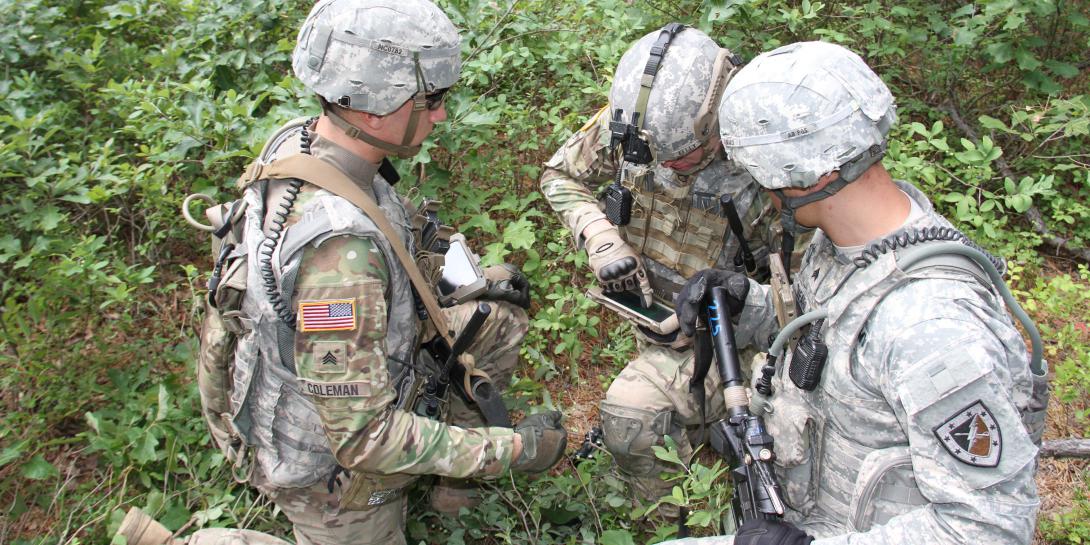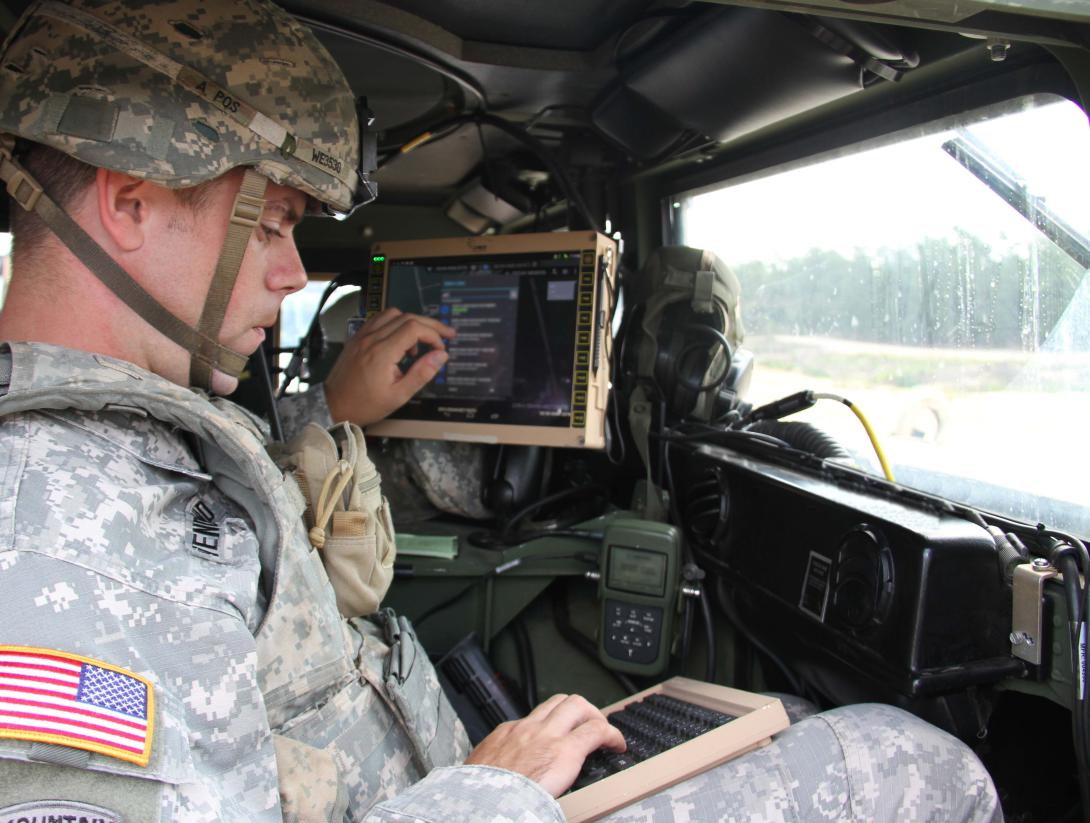Driving Expeditionary Change
Mobility plays a salient role as the U.S. Army refashions itself into a leaner, more expeditionary force. In a few short years, military commanders will direct entire battles with mere finger swipes on handheld tablets or even smaller devices. From their palms, warrior leaders will know the precise positions of ground forces, air assets, unmanned sensors, medics and more—all part of a concept in motion to modernize the service over the next decade and beyond.
Imagine mobile devices replacing the half-dozen mounted 40-inch big-screen TVs in tactical operation centers, says Col. Michael Thurston, USA, project manager for Mission Command, U.S. Army Program Executive Office Command Control Communications-Tactical (PEO C3T). Gone too could be the mammoth servers that provide critical network connections to today’s troops in combat zones.
As the Army’s tactical network evolves, soldiers will be able to send and receive critical information via handheld devices, use smartphones to diagnose and treat sickened troops, and even recharge power sources simply by walking. The service envisions a more agile on-the-move force.
The Joint Battle Command-Platform (JBC-P), which the Army plans to field in 2017, could help it achieve this goal. The force tracking system uses a faster satellite network, secure data encryption and advanced logistics, Col. Thurston says. Soldiers will be aided by JBC-P’s interface with touch-to-zoom maps and drag-and-drop icons, and a handheld version will run on the Nett Warrior system.
Despite such technological advances, challenges persist with integrating various Army applications and hardware systems across military specialties. For example, getting applications on dismounted soldiers’ handheld devices to talk to systems in a commander’s vehicle or within a tactical command post has proved troublesome between operational and intelligence forces. Today’s systems are too fragmented by “functional area,” says Paul Mehney, director of public affairs at PEO C3T. “Looking at the programmatic base lines that we have now, we realize that we need to continue development and integration efforts to achieve a less complex network,” he says. “What we will end up with is an actual increase in user simplicity because I’m not on different boxes or different systems. Now I’m on a device [where I can] go to any application I need, hit a button, and it comes up.”
The migration to mobile applications means commanders will not have to access different platforms or devices—and understand how to operate each one—to accomplish missions when on the move. This approach fixes the disconnect created by the traditional stovepiped acquisition programs, Mehney continues. “I have very good individual systems that work very well against individual functions,” he says. “My intelligence systems are good and work for my intelligence guys. My mission command system is good, and it works well for the operations guys. What they don’t do well is share data back and forth because they weren’t originally designed to do that.”
Simplifying network and mission command capabilities is an Army priority. The efforts, outlined in a strategy called Force 2025 and Beyond, mesh with the overarching Army modernization scheme to improve land power effectiveness. “It means driving to a common set of hardware standards so you begin to reduce the complexity of your command post, both static and on the move,” Mehney says. “We’re leveraging existing Army programs of record and joint battle command platforms. Part of what we’re challenged with currently on the tactical network side of fielding is how to make our systems more expeditionary. A key part of that is being able to build and scale the network to support those types of operations.”
Researchers from the Communications-Electronics Research, Development and Engineering Center (CERDEC) lead most of the modernization efforts. For example, they teamed with the Research, Development and Engineering Command’s Edgewood Chemical Biological Center to marry two distinct fields’ emerging technologies: testing for pathogens and chemical exposure and leveraging secure, tactical 4G Long Term Evolution (LTE) as an asset while assessing various communication methods. Using an aerostat for the command’s persistent ground surveillance systems, researchers developed a tactical solution to provide the coveted broadband service even in the most far-flung and underdeveloped corners of the Earth. “In the civilian world, you have a lot of infrastructure that’s extremely well-connected, with cellphone towers that [regularly] have backhaul connections through the ground that allow you to do a lot and get a lot of bandwidth everywhere,” says Brian Casey, an electronics engineer with the Commercial Technology Integration and Evaluation Branch of CERDEC’s Space and Terrestrial Communications Directorate (S&TCD). “The Army is on the move, and that’s the big challenge.”
New technologies are meeting the need for mobility. Medics, for example, will be the primary users of a dedicated, secure, high-speed service to send critical information collected from patients in the field to a battalion medical aid station. Using smartphones modified into assay readers, medics can collect a sample from a patient using a dipstick and then run a diagnostic test. Researchers say that eventually the device will be able to run up to 40 tests, including for strep throat, Ebola and exposure to ricin.
The handheld devices also contain applications including medical manuals and guidebooks to give medics step-by-step treatment options for patients. In addition, CERDEC is testing a device called the Tempus Pro, a small, lightweight, rugged system that lets field medics monitor vital signs such as heart rate, take sonograms to check for broken bones or abdominal wounds and even help insert a laryngoscope to aid with breathing.
Another mobility project involves the energy-harvesting assault pack, or EHAP, which both reduces the amount of weight troops must carry and provides an on-the-move battery-charging station. Army-issued backpacks are attached to a spring-suspended plastic frame. As soldiers walk or run, the backpack moves up and down and generates electricity that can be used to recharge batteries or portable electronics.
CERDEC’s S&TCD also is working to improve data mule capabilities. Disruption-tolerant networking (DTN), which uses data mules to exchange data among computers that do not have access to the TCP/IP-based Internet, provides a “store-forward capability” to mitigate problems when network services fail after troops transfer files from the field to a headquarters element, says David Yee, an electronics engineer with CERDEC’s Systems Engineering, Architecture, Modeling and Simulation (SEAMS) Division. “This will allow the soldier … to not worry about getting that data delivered,” he explains. “Our software DTN will be responsible for delivering that message, that data, to its final destination.” It can retrieve data using unmanned aerial vehicles that fly over troops transmitting data via radios or using vehicles that drive by and perform the same function. If the network is down, DTN stores the data until the network comes back online.
Of course, the migration to a more agile force would not happen without input from the U.S. Army Training and Doctrine Command, which teamed with CERDEC to develop the Expeditionary Command Post Capabilities project. For the brigade level and below, CERDEC developed the Light-Mobile Command Post, a light vehicle equipped with capabilities that, within five minutes, can be operational as a command post. The vehicle’s mounted communications systems, part of the Warfighter Information Network-Tactical (WIN-T) Increment 1 wireless connectivity project, provide rapid and secure communications, and the onboard power system means it does not have to lug or tow a heavy generator—all part of increasing soldiers’ mobility.







Comments